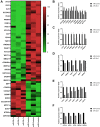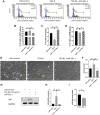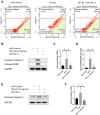miR-30c-1 encourages human corneal endothelial cells to regenerate through ameliorating senescence
- PMID: 33744867
- PMCID: PMC8064150
- DOI: 10.18632/aging.202719
miR-30c-1 encourages human corneal endothelial cells to regenerate through ameliorating senescence
Abstract
In the present study, we studied the role of microRNA-30c-1 (miR-30c-1) on transforming growth factor beta1 (TGF-β1)-induced senescence of hCECs. hCECs were transfected by miR-30c-1 and treated with TGF-β1 to assess the inhibitory effect of miR-30c-1 on TGF-β1-induced senescence. Cell viability and proliferation rate in miR-30c-1-transfected cells was elevated compared with control. Cell cycle analysis revealed that cell abundance in S phase was elevated in miR-30c-1-treated cells compared with control. TGF-β1 increased the senescence of hCECs; however, this was ameliorated by miR-30c-1. TGF-β1 increased the size of hCECs, the ratio of senescence-associated beta-galactosidase-stained cells, secretion of senescence-associated secretory phenotype factors, the oxidative stress, and arrested the cell cycle, all of which were ameliorated by miR-30c-1 treatment. miR-30c-1 also suppressed a TGF-β1-induced depolarization of mitochondrial membrane potential and a TGF-β1 stimulated increase in levels of cleaved poly (ADP-ribose) polymerase (PARP), cleaved caspase 3, and microtubule-associated proteins 1A/1B light chain 3B II. In conclusion, miR-30c-1 promoted the proliferation of hCECs through ameliorating the TGF- β1-induced senescence of hCECs and reducing cell death of hCECs. Thus, miR-30c-1 may be a therapeutic target for hCECs regeneration.
Keywords: TGF-β; human corneal endothelial cells; miR-30c-1; proliferation; senescence.
Conflict of interest statement
Figures








Similar articles
-
A p-Tyr42 RhoA Inhibitor Promotes the Regeneration of Human Corneal Endothelial Cells by Ameliorating Cellular Senescence.Antioxidants (Basel). 2023 May 30;12(6):1186. doi: 10.3390/antiox12061186. Antioxidants (Basel). 2023. PMID: 37371916 Free PMC article.
-
High-concentration atropine induces corneal epithelial cell apoptosis via miR-30c-1/SOCS3.Kaohsiung J Med Sci. 2022 Nov;38(11):1113-1122. doi: 10.1002/kjm2.12598. Epub 2022 Sep 26. Kaohsiung J Med Sci. 2022. PMID: 36156413 Free PMC article.
-
MiR-302a Regenerates Human Corneal Endothelial Cells against IFN-γ-Induced Cell Death.Cells. 2022 Dec 22;12(1):36. doi: 10.3390/cells12010036. Cells. 2022. PMID: 36611829 Free PMC article.
-
Adipose Mesenchymal Stem Cell-Derived Exosomes Promote the Regeneration of Corneal Endothelium Through Ameliorating Senescence.Invest Ophthalmol Vis Sci. 2023 Oct 3;64(13):29. doi: 10.1167/iovs.64.13.29. Invest Ophthalmol Vis Sci. 2023. PMID: 37850944 Free PMC article.
-
[Transplantation of corneal endothelial cells].Nippon Ganka Gakkai Zasshi. 2002 Dec;106(12):805-35; discussion 836. Nippon Ganka Gakkai Zasshi. 2002. PMID: 12610838 Review. Japanese.
Cited by
-
Emerging Role of MicroRNA-30c in Neurological Disorders.Int J Mol Sci. 2022 Dec 20;24(1):37. doi: 10.3390/ijms24010037. Int J Mol Sci. 2022. PMID: 36613480 Free PMC article. Review.
-
A p-Tyr42 RhoA Inhibitor Promotes the Regeneration of Human Corneal Endothelial Cells by Ameliorating Cellular Senescence.Antioxidants (Basel). 2023 May 30;12(6):1186. doi: 10.3390/antiox12061186. Antioxidants (Basel). 2023. PMID: 37371916 Free PMC article.
-
New insights into the cardio-renal benefits of SGLT2 inhibitors and the coordinated role of miR-30 family.Genes Dis. 2023 Nov 23;11(6):101174. doi: 10.1016/j.gendis.2023.101174. eCollection 2024 Nov. Genes Dis. 2023. PMID: 39224109 Free PMC article. Review.
-
MicroRNA of Epithelial to Mesenchymal Transition in Fuchs' Endothelial Corneal Dystrophy.Genes (Basel). 2022 Sep 23;13(10):1711. doi: 10.3390/genes13101711. Genes (Basel). 2022. PMID: 36292595 Free PMC article. Review.
-
High-concentration atropine induces corneal epithelial cell apoptosis via miR-30c-1/SOCS3.Kaohsiung J Med Sci. 2022 Nov;38(11):1113-1122. doi: 10.1002/kjm2.12598. Epub 2022 Sep 26. Kaohsiung J Med Sci. 2022. PMID: 36156413 Free PMC article.
References
-
- Matsubara M, Tanishima T. Wound-healing of the corneal endothelium in the monkey: a morphometric study. Jpn J Ophthalmol. 1982; 26:264–73. - PubMed
-
- Fujikawa LS, Wickham MG, Binder PS. Wound healing in cultured corneal endothelial cells. Invest Ophthalmol Vis Sci. 1980; 19:793–801. - PubMed
-
- Yang HJ, Sato T, Matsubara M, Tanishima T. [Wound healing of the corneal endothelium in the bullous keratopathy after keratoplasty]. Nippon Ganka Gakkai Zasshi. 1983; 87:701–7. - PubMed
Publication types
MeSH terms
Substances
LinkOut - more resources
Full Text Sources
Other Literature Sources
Research Materials

